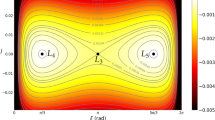Abstract
In this paper we describe a model for the tidal evolution of an orbit-orbit resonance between two satellites of the same planet. We let the system evolve till infinity or until the resonance is destroyed. We find that there are asymptotic values for the eccentricities and inclinations. We list the possible final stages that a resonance can achieve, we give a few examples, and finally we discuss the limitations of the model and its possible applications to real systems.
Similar content being viewed by others
References
Allan, R. R.: 1967, ‘Resonance effects due to the longitude dependence of the gravitational field of a rotating primary’,Planet. Space Sci. 15, 53–76.
Allan, R. R.: 1969, ‘Evolution of Mimas-Tethys commensurability’,Astron. J. 74, 497–506.
Burns, J. A.: 1986, ‘The evolution of satellite orbits’, in J. A. Burns and M. S. Matthews (eds.),Satellites, pp 117–158, Univ. of Arizona Press, Tucson, Arizona.
Cohen, C. J. and Hubbard, E. C.: 1965, ‘Libration of close approaches of Pluto to Neptune’,Astron. J. 70, 10–13.
Dermott, S. F.: 1972, ‘Bode's law and the preference for near-commensurability among pairs of orbital periods in the Solar System’, in H. Reeves (ed.),On the Origin of the Solar System, pp 320–335, CNRS, Paris.
Goldreich, P.: 1965, ‘An explanation of the frequent occurence of commensurable mean motions in the Solar System’,Mon. Not. R. Astron. Soc. 130, 159–181.
Henrard, J. and Lemaître, A.: 1983, ‘A second fundamental model for resonance’,Celest. Mech. 30, 197–218.
Kaula, W. M.: 1962, ‘Development of the lunar and solar disturbing functions for a close satellite’,Astron. J. 67, 300–303.
Kaula, W. M.: 1964, ‘Tidal dissipation by solid friction and the resulting orbital evolution’,Rev. Geophys. 2, 661–685.
Kovalevsky, J.: 1984, ‘Non-gravitational forces in the evolution of the Solar System’, in A. Berger (ed.),The Big Bang and Georges Lemaître, pp. 181–194, D. Reidel, Dordrecht/Boston/Lancaster.
Malhotra, R. and Dermott, S. F.: 1990, ‘The role of secondary resonances in the orbital history of Miranda’,Icarus 85, 444–480.
Marsden, B. G.: 1966,‘The Motions of the Galilean Satellites of Jupiter’, Ph.D. thesis, Yale Univ.
Pauwels, T.: 1986, ‘On the possibility of a “cuckoo-effect” in the Earth-Moon system’, in K. B. Bhatnagar (ed.),Space Dynamics and Celestial Mechanics, pp. 129–141, D. Reidel, Dordrecht/Boston/Lancaster/Tokyo.
Plummer, H. C.: 1960,An Introductory Treatise on Dynamical Astronomy, Dover Publications, Inc., New York.
Williams, J. G. and Benson, G. S.: 1971, ‘Resonances in the Neptune-Pluto system’,Astron. J. 76, 167–177.
Yoder, C. F.: 1973, ‘On the Establishment and Evolution of Orbit-Orbit Resonances’, Ph.D. thesis, Univ. Calif. Santa-Barbara.
Yoder, C. F.: 1979, ‘How tidal heating in Io drives the galilean orbital resonance locks’,Nature 279, 767–770.
Author information
Authors and Affiliations
Rights and permissions
About this article
Cite this article
Pauwels, T. Final tidal evolution of orbit-orbit resonances. Celestial Mech Dyn Astr 59, 101–127 (1994). https://doi.org/10.1007/BF00692128
Received:
Accepted:
Issue Date:
DOI: https://doi.org/10.1007/BF00692128




